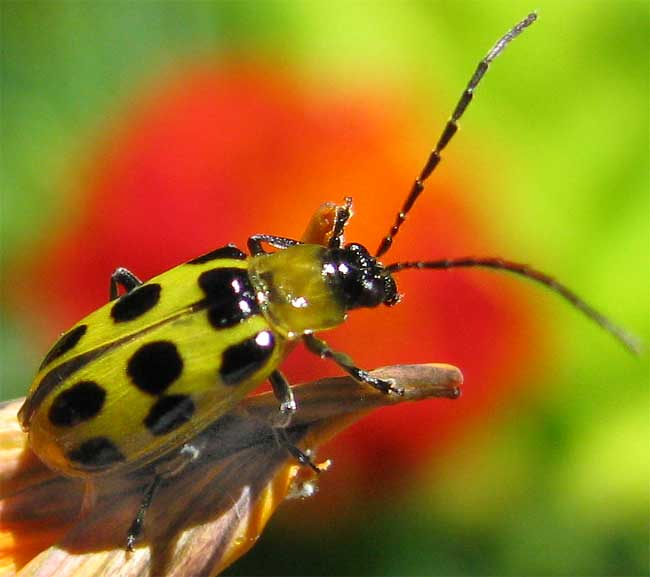Excerpts from Jim Conrad's
Naturalist Newsletter

from the July 5, 2009 Newsletter, issued from the Siskiyou Mountains west of Grants Pass, Oregon:
SPOTTED CUCUMBER BEETLE
Above you see an insect found in many gardens, the Spotted Cucumber Beetle, DIABROTICA UNDECIMPUNCTATA. This one was in our garden; the red background is provided by a nasturtium flower.
Though Spotted Cucumber Beetles look like green ladybugs the two beetle types shouldn't be confused. Ladybugs should be welcome guests, for they eat many of the creatures who eat garden plants. Spotted Cucumber Beetles have a much different reputation.
Adult cucumber beetles eat leaves of cucumber, squash, watermelon, and other vine crops, causing a special kind of damage known as "window-panning." Window- panning results when the beetle eats the lower surface and inside of a leaf, leaving the upper surface intact but causing it to turn brown. Typically so few cucumber beetles inhabit a garden that their chewing damage is negligible.
Much more dangerous to the garden is the beetle's ability to transmit bacterial wilt disease causing the early death of cucumbers and muskmelons. Just one beetle per plant can transmit the disease to a large portion of plants in a garden. Gardeners raising lots of vine crops but unwilling to use insecticides often plant Zucchini and Blue Hubbard squash to draw the beetles away from the real crops, since cucumber beetles are especially fond of Zucchini and Blue Hubbards.
In much of the country the damage done by Spotted Cucumber Beetle adults is nothing to be compared with that done by its larval stage, which is known as the Corn Rootworm, and which can severely damage corn crops.